In the vibrant heart of Genoa lies an exclusive and unexpected treasure: the Rolli Palaces — aristocratic residences built between the 16th and 18th centuries, now recognized as a UNESCO World Heritage Site. Strolling through the historic streets of Via Garibaldi and the old town reveals a stunning sequence of magnificent palaces that embody centuries of history, art, and power.
But what exactly are the Rolli — and why should you absolutely know about them? These majestic and captivating buildings are the key to a living past, revealing a lesser-known and fascinating side of La Superba, steeped in Renaissance charm and mystery.
Among frescoed halls and enchanting gardens, you can explore the unique legacy of the Rolli thanks to initiatives such as the Rolli Days, when many normally closed palaces open their doors, such as the guided tour “The Splendid Genoese Residences of the 16th Century” held every Saturday, and the Rolli Experience, which offers personalized guided tours throughout the year. A unique and original way to discover the most authentic and refined side of Genoa’s magnificent historic center.
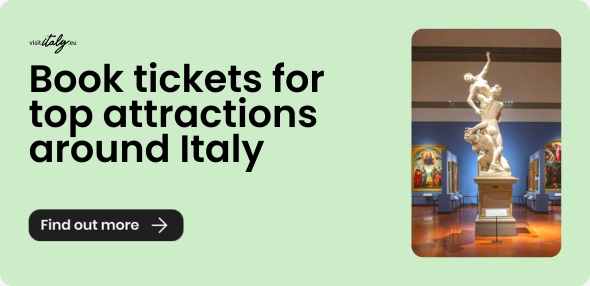
Why were the Rolli Palaces important, and what was their role?
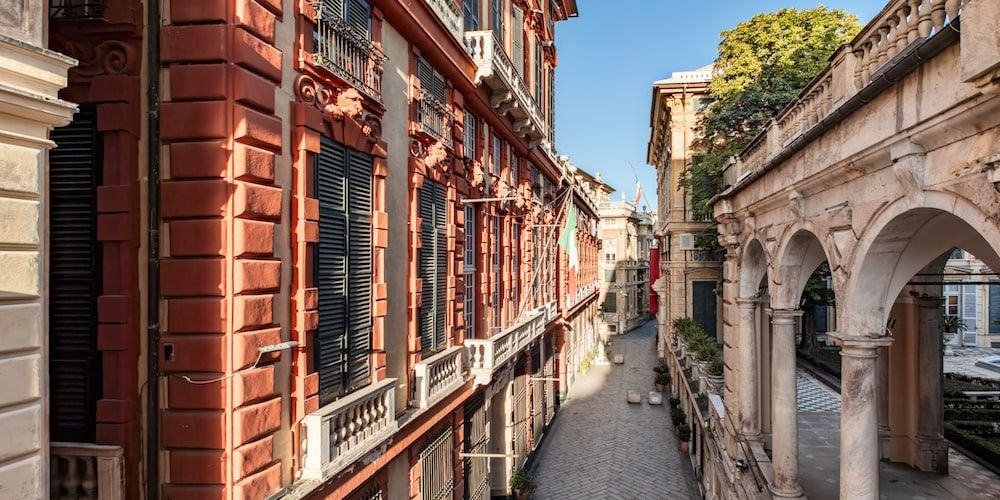
Via Garibaldi 3 - Photo I.Murtas
What’s the meaning of “Rolli”? It’s a term referring to the official lists through which the Republic of Genoa assigned private palaces the duty of hosting ambassadors, princes, and dignitaries visiting the city. Since there were no official royal residences, public hospitality was entrusted precisely to this network of private palaces, selected according to their size, prestige, and importance.
More than 100 palaces were selected to host distinguished guests: 42 of them are now protected as UNESCO World Heritage Sites. The Rolli Palaces were divided into various levels, each intended to accommodate guests of different ranks. This system perfectly reflected the reputation of a city that has always made hospitality a distinctive sign of its greatness.
Even today, the Rolli Palaces speak through their grand entrances, staircases, and frescoes: iconic testaments to Genoa’s glorious past. Here is a journey not to be missed in Genoa, that will take you through the historic center to discover 10 of its most representative palaces, revealing their most authentic identity through refined architecture and timeless atmospheres.
Discover more about the Rolli Palaces10. Palazzo Bianco: the oldest of the Rolli Palaces
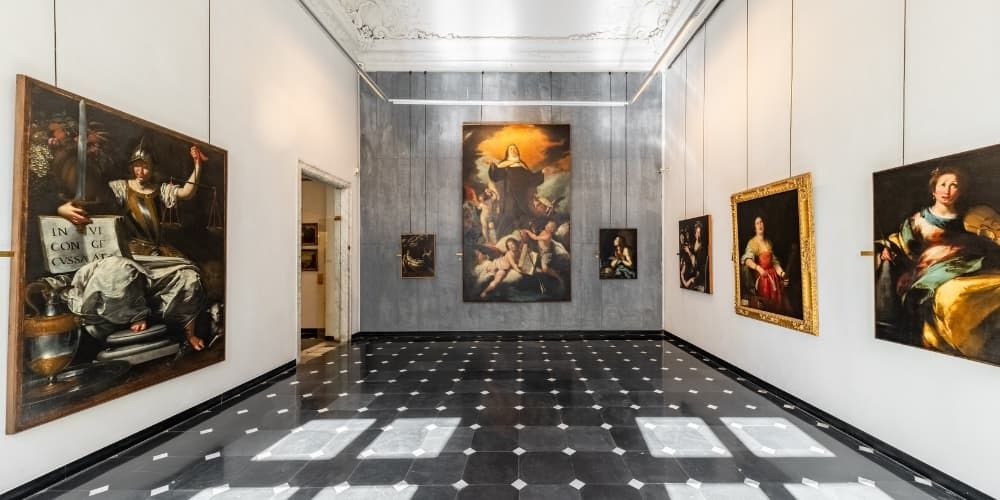
Palazzo Bianchi -Photo I.Murtas
– Where is it located? Our itinerary through the Rolli Palaces of Genoa begins on Via Garibaldi, the ancient “Strada Nuova,” built in the sixteenth century to house the most prestigious residences of the Genoese aristocracy.
As soon as you enter the street, on the left you can admire Palazzo Bianco, constructed between 1530 and 1540 for Luca Grimaldi, a member of one of the oldest Genoese families. It's the oldest palace on Strada Nuova, although it was almost entirely renovated at the beginning of the 18th century; from the original residence, only the statues of Jupiter and Janus on the staircase remain.
– What to see? Inside, you will find a splendid art gallery, an unexpected collection of clothing and textiles, a precious garden, and an archaeological path that takes you back in time.
– What makes it special? At Palazzo Bianco, you'll discover an art collection safeguarding masterpieces of the highest caliber, ranging from Ligurian painting to Venetian, Lombard, Flemish, and Spanish works with masterpieces from the 15th to the 18th century.
9. Palazzo Rosso: a legacy of art and elegance
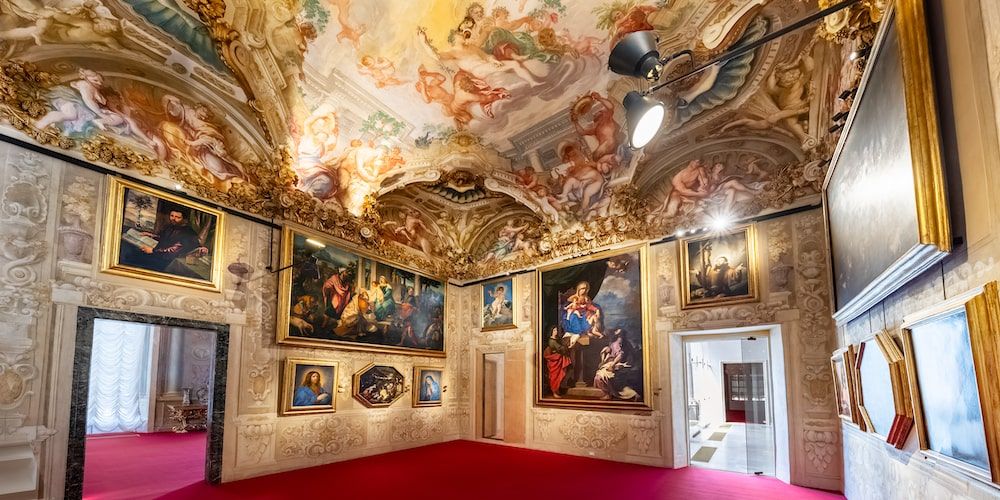
Palazzo Rosso - Photo I.Murtas
– Where is it? Leaving Palazzo Bianco, it takes just a few steps to find yourself right in front of the deep red façade of Palazzo Rosso, built in the second half of the 17th century by the powerful Brignole Sale family. It was Maria Brignole Sale De Ferrari, Duchess of Galliera, who donated the palace to the city in 1874.
– What to see? Crossing the threshold feels like stepping back in time: the second piano nobile still preserves original 17th-century frescoes, wood paneling, and furnishings that offer a glimpse into noble life in Baroque Genoa. The art collection is equally impressive, featuring seven paintings by Van Dyck and masterpieces by Guido Reni, Guercino, Veronese, and Bernardo Strozzi.
– What makes it special? There is a refined, self-aware elegance in every detail of the palace, which over the centuries has evolved and been enriched—from the 17th-century rooms to the extraordinary 18th-century Alcove, and all the way to the 20th-century apartment designed by Franco Albini, which converses with the original layout.
8. Palazzo Tursi: the most majestic palace on Strada Nuova
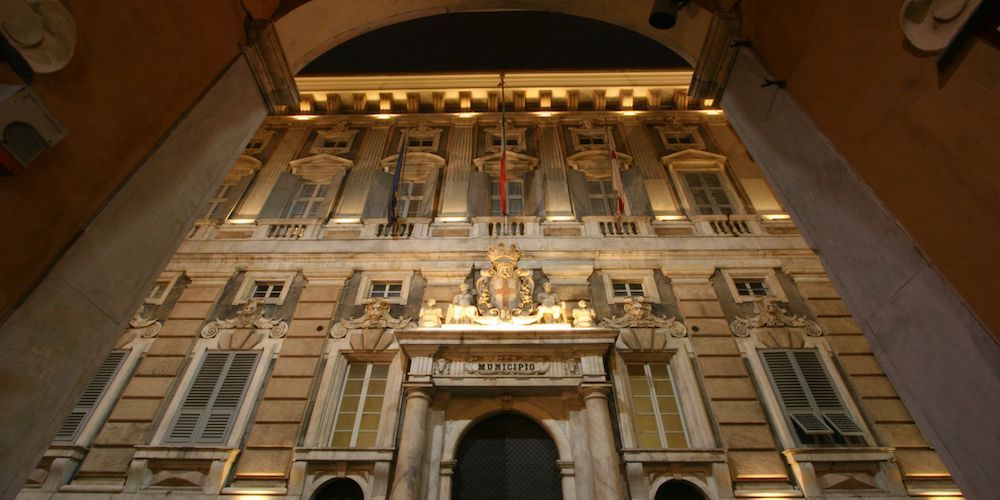
– Where is it? Just after leaving Palazzo Rosso, before you even make it back to Via Garibaldi, the monumental façade of Palazzo Tursi appears before you. It’s the largest of all the Strada Nuova palaces, built in 1565 for Niccolò Grimaldi—nicknamed “the Monarch” for his immense wealth. The palace later passed to the Doria family, then to the House of Savoy, and today it houses the Genoa City Hall.
– What to see? Head up to the piano nobile to find 18th-century artworks, including Canova’s Magdalene, collections of ceramics and coins, and even a legendary violin—the “Cannone”, crafted by Guarneri del Gesù and once owned by Paganini.
– What makes it special? Though the museum is smaller than those in Palazzo Rosso and Palazzo Bianco, this palace offers a rich experience, full of history and elegance. What truly stands out is the building itself: the most majestic along the street, with a grand double staircase, a loggia courtyard, and refined architectural details that still impress today.
7. Palazzo Nicolosio Lomellino: art, architecture, and secret gardens
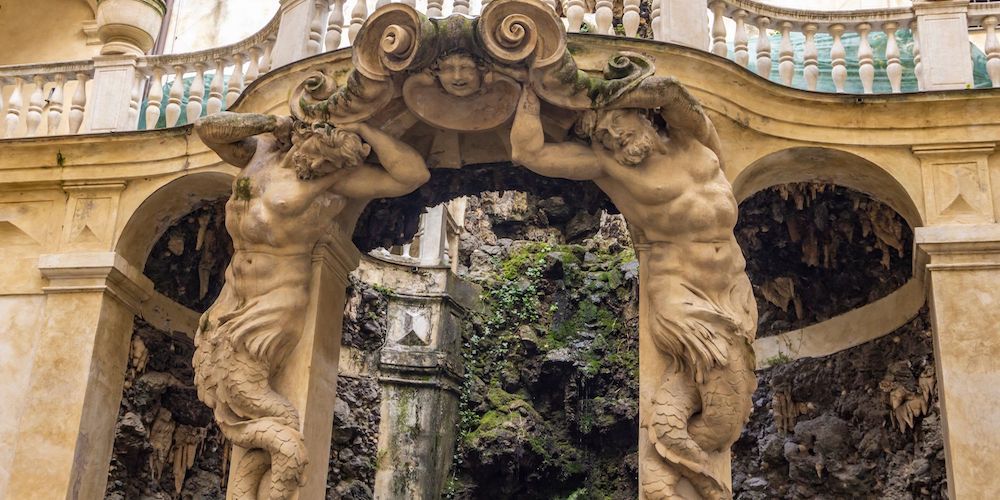
- Where is it? Just a few steps from Palazzo Tursi, walk along the street and on your left, a stunningly decorated façade appears: Palazzo Nicolosio Lomellino, built in the 16th century for the eponymous Genoese merchant by architect Giovanni Battista Castello, known as Il Bergamasco.
- What to see? Be enchanted by the spectacular sequence of the atrium, entrance hall, and courtyard opening onto Strada Nuova, adorned with a stucco façade in an elegant and unique style.
Inside, you can admire the 17th-century frescoes by Bernardo Strozzi dedicated to the discovery of America, long thought lost and recently restored. But the real treasure is the 18th-century nymphaeum: a truly evocative space connecting street level to two hanging gardens, enriched by statues, fountains, and grottos.
- What makes it special? Palazzo Lomellino is an unexpected window into Renaissance Genoa, surprising you not only with its art and architecture but especially with its refined hanging gardens — a charming and unexpected green oasis in the heart of the historic center.
6. Palazzo Tobia Pallavicino – Chamber of Commerce: where past and present meet
– Where is it located? There are still several stunning palaces on Via Garibaldi, like Palazzo Doria, Palazzo Lercari-Parodi, Palazzo Pallavicini-Cambiaso, and especially Palazzo Tobia Pallavicino, which houses the Chamber of Commerce. This building was constructed in the mid-16th century by the very wealthy Marquis Tobia Pallavicino.
– What to see? The spectacular Golden Gallery, created in the 18th century by the Carrega family to amaze visitors: every surface, from walls to ceiling, is covered with mirrors, gilded stuccoes, carved wood, and frescoes, creating a bright and opulent atmosphere. A unique example of Baroque decoration that will leave you breathless.
– What makes it special? The charm of the Golden Gallery, of course, but there’s more. The palace has a history of transformations and restorations that have maintained its integrity: in this way, the Baroque elegance of the past blends with a modern public function, letting you discover a side of Genoa that wonderfully unites past and present.
5. The Renaissance elegance of Palazzo della Meridiana
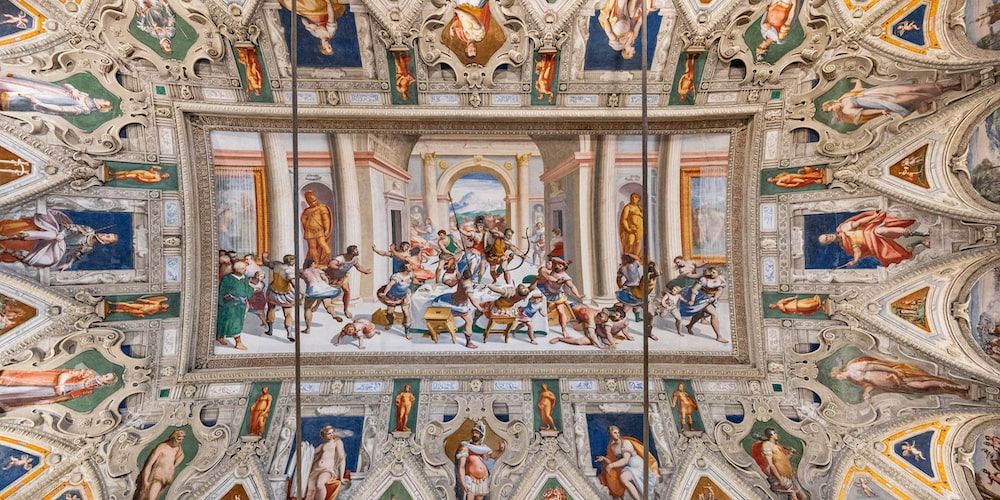
Fresco at Palazzo della Meridiana – Photo: CA Alessi
- Where is it located? Before leaving via Garibaldi to explore the historic center, in Piazza della Meridiana you can appreciate the splendid elegance of one of Genoa’s earliest examples of Renaissance architecture: Palazzo della Meridiana, constructed between 1536 and 1545, even before Strada Nuova was built, by the will of the Grimaldi Oliva family.
- What to see? The magnificent exterior of Palazzo della Meridiana stands out for its Renaissance elegance, anticipating the style of Strada Nuova. The interior is accessible only during exhibitions, events, or the Rolli Days. If you have the chance to enter, don’t miss Luca Cambiaso’s fresco depicting Ulysses among the Suitors, renowned for its innovative use of perspective.
- What makes it special? Its limited accessibility to special occasions makes every visit an exclusive, almost intimate experience, offering a chance to discover a lesser-known but equally captivating side of Genoa.
4. Beyond “Strada Nuova”: Palazzo Spinola di Pellicceria
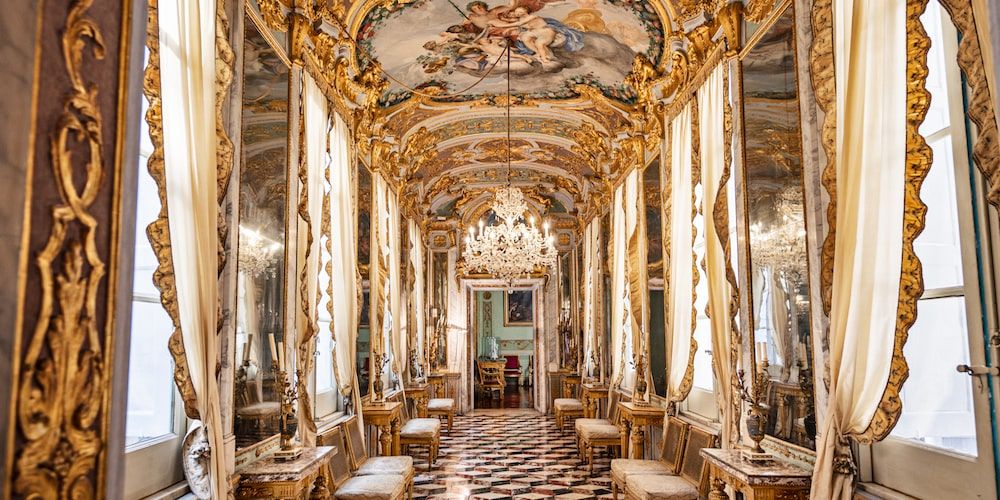
Palazzo Spinola, Hall of Mirrors - Photo CA Alessi
– Where is it located? Did you enjoy the palaces on Via Garibaldi? Remember that the Rolli Palaces are not only found along the historic and picturesque Strada Nuova, but are scattered throughout Genoa’s city center. From Piazza delle Fontane Marose, just past Via Garibaldi, take Via Luccoli and wander through the city’s narrow streets until you reach Piazza di Pellicceria, where Palazzo Spinola awaits. Built at the end of the 16th century, it was donated to the state in 1958.
– What to see? Palazzo Spinola di Pellicceria is a noble residence turned museum. It tells centuries of Genoese aristocratic life, showcasing original furnishings and masterpieces by Rubens, Van Dyck, Antonello da Messina, and Guido Reni. Don’t miss the little Hall of Mirrors and the enchanting views from the upper floors.
– What makes it special? With its furnishings that have survived intact to the present day and artistic details, every room in the palace conveys the atmosphere of sophisticated luxury typical of the Rolli Palaces, telling the story of aristocratic life from a bygone era that still lives on in the elegance of its halls.
3. The Rolli Palaces of Via Balbi: Palazzo Gio Francesco Balbi
– Where is it? From Piazza della Pellicceria, walk along Via Fossatelli and Via Lomellini, then turn left to reach Piazza della Nunziata. Here, next to the impressive Basilica of the Santissima Annunziata del Vastato, begins Via Balbi: at number 2 you’ll find Palazzo Gio Francesco Balbi. Built in the 16th century as the main residence of the Balbi family, it was renovated in the 18th century by the Cattaneo family and is now part of the university.
– What to see? The historic charm and elegance of the palace are still evident on the second floor, in the grand hall that houses the Cattaneo family’s picture gallery, with beautiful portraits by Vaymer and Pellegro Parodi.
– What makes it special? Restored and partially rebuilt after World War II, the palace was given new life as the home of the Faculty of Humanities of the University of Genoa. Here, among frescoes and works of art, study meets history in a place where aristocratic heritage blends with contemporary knowledge.
2. Palazzo Giacomo e Pantaleo Balbi
– Where is it? Just a few steps beyond Palazzo Gio Francesco Balbi, at number 4, stands another magnificent building, constructed in 1618 by the brothers Giacomo and Pantaleo Balbi.
– What to see? The original layout featured two identical noble floors stacked above a large inner courtyard, while later additions included a hanging garden with a decorated nymphaeum and a loggia transformed into a gallery. The second floor houses stunning frescoes depicting the mythological tale of the Rape of Proserpina.
– What makes it special? Now owned by the University of Genoa, Palazzo Giacomo e Pantaleo Balbi preserves one of the richest fresco cycles in the city, retaining the full charm of the ancient Baroque-era aristocracy: among hanging gardens, frescoed halls, and galleries, it remains one of the places where the city’s artistic and intellectual soul has been woven over the centuries.
1. The unique charm of Palazzo Reale
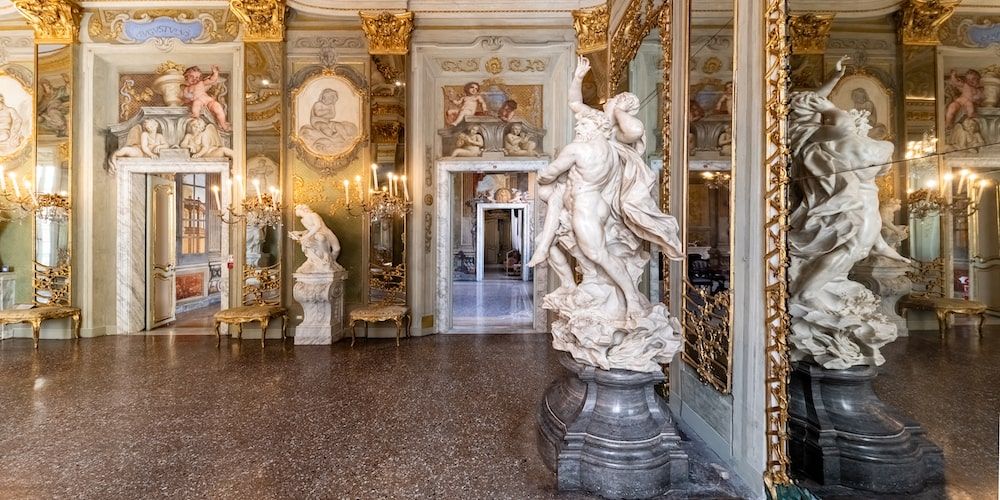
Palazzo Reale - Photo I.Murtas
– Where is it? Keep walking along Via Balbi: on your left, opposite the Church of San Carlo, you’ll find the extraordinary Palazzo Reale. Dating back to the first half of the 17th century, it was commissioned by Stefano Balbi.
– What to see? This is the most sumptuous building on the street and one of the most spectacular in the entire city. Once the residence of the Balbi family, then the Durazzo, and finally the House of Savoy, today it’s a museum that preserves original furnishings, frescoes, mirrors, works by Van Dyck and Tintoretto, and a magnificent Hall of Mirrors. From the balcony, you can enjoy a stunning view of the Old Port, where the famous Acquarium is also located
– What makes it special? The wonderful Hall of Mirrors, the beating heart of the palace, reflects the legacy of three centuries of noble splendor. In this space, suspended between art and power, Genoa reveals its most regal soul.
Rolli Days and Rolli Experience: two unique ways to unveil Genoa’s secrets
This itinerary through Via Garibaldi and Via Balbi is just one of the many paths leading to some of the most captivating Rolli Palaces. But the Rolli are far more numerous — 42 in total, scattered across the city, many of which are normally closed to the public.
That’s where the Rolli Days come in: a beloved event that lights up Genoa in spring and autumn. For a few days, dozens of usually inaccessible palaces open their doors, welcoming you into halls and frescoed rooms that seem frozen in time, with guided tours led by Scientific Communicators – young, knowledgeable, and passionate scholars. You’ll experience a vibrant, curious atmosphere as you explore the city’s oldest and most aristocratic soul.
Looking for something more intimate, away from the crowds? With the Rolli Experience, you can enjoy the Rolli Palaces year-round: themed tours, overnight stays in accommodations within the palaces, and exclusive itineraries that reveal a more refined and surprising side of Genoa.
It’s the perfect way to enjoy the hidden beauty behind elegant portals and stunning façades, guided by those who know every story and every detail. A slow, unforgettable journey into the true heart of Genoa “La Superba” — and the magnificent Palazzi dei Rolli.
And don’t forget that every Saturday you can also join the guided tour led by licensed tour guides, “The Splendid 16th-Century Genoese Residences.”
Visiting Genoa and the Rolli Palaces: FAQs you should know
1. How can you visit the Rolli Palaces?
Some Rolli Palaces – like Palazzo Rosso, Palazzo Bianco, Palazzo Tursi, Palazzo Reale and Palazzo Spinola – are open all year round. Others, usually closed to the public, can be visited during the Rolli Days, two events held each spring and autumn, with free guided tours. If you’re looking for a more exclusive or off-season experience, the Rolli Experience offers themed tours, special openings and visits by reservation.
2. How many Rolli Palaces are there in Genoa?
More than 100 palaces were historically part of the Rolli system. Of these, 42 have been included in the UNESCO World Heritage Site “Le Strade Nuove and the system of the Rolli Palaces”.
3. Where are the Rolli Palaces located?
Most of the palaces are concentrated along Via Garibaldi and Via Balbi, but many are nestled in the heart of Genoa’s historic center and are easily reachable on foot.
4. Which is the most beautiful palace to visit?
Palazzo Reale, Palazzo Rosso and Palazzo Spinola are among the most famous and scenic. But each palace has its own charm and history: the best one for you depends on whether you're more drawn to art, architecture or the lives of the noble families who lived there.
5. How much does it cost to visit the Rolli Palaces?
During the Rolli Days, admission to many palaces is free. Outside of these events, the palaces that have become museums have an entrance fee ranging from €9 to €12, with reduced rates available. A Museums Card, which includes all of them, is also available. For more details, you can visit the Museums of Genoa website. The Rolli Experience, on the other hand, has a variable cost depending on the tour you choose.
6. Are the Rolli Palaces accessible to everyone?
Many of these historic buildings have stairs, courtyards and uneven flooring. Some are accessible to people with reduced mobility, but it’s best to check in advance, as access conditions vary from one palace to another.
About the author
Written on 01/09/2025

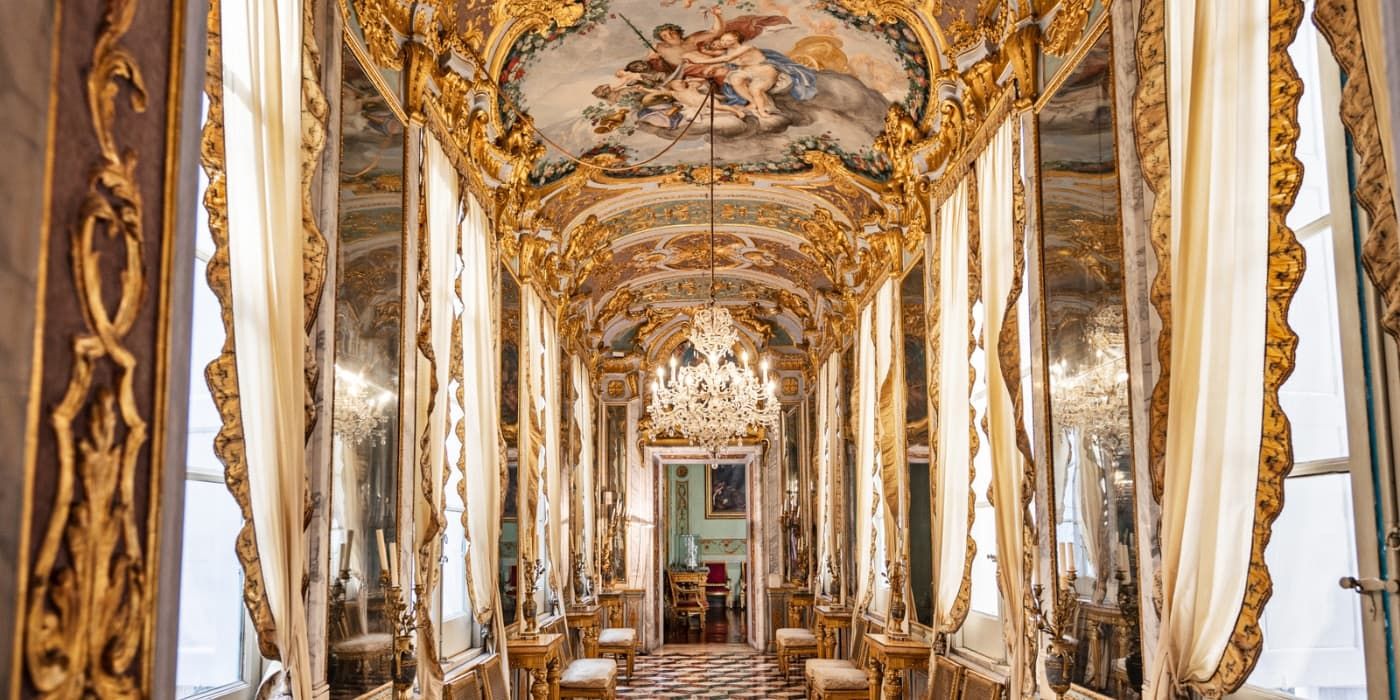

Alessandro Savino
Discover the Rolli Palaces, one of Genoa’s best-kept secrets, on a journey through 10 of these magnificent UNESCO-listed residences.